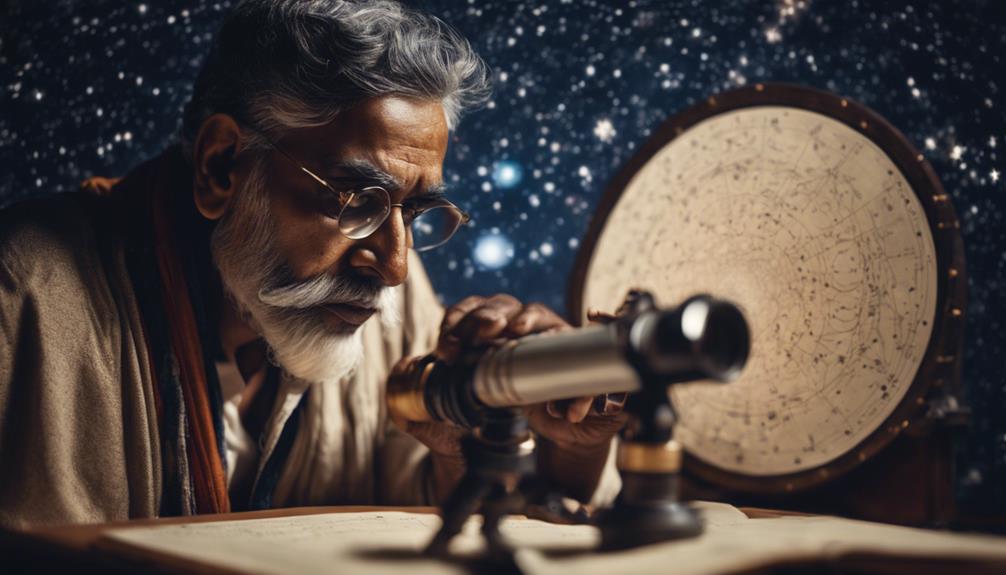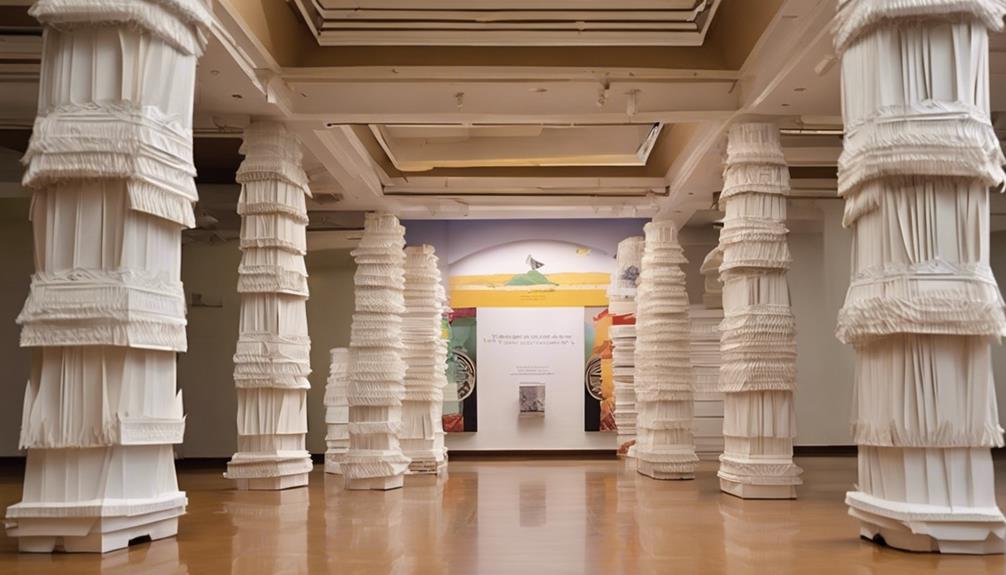Aryabhatta, an ancient Indian mathematician and astronomer, is an overlooked genius whose contributions have profoundly impacted mathematics and astronomy globally. His revolutionary work predates Greek advancements and influences modern physics. Aryabhatta's innovative methods for time computation and calendar systems showcase his deep understanding of celestial mechanics. His renowned treatise, the Aryabhatiya, introduced concepts like zero and decimal systems, shaping scientific thought for centuries. Despite his profound impact, Aryabhatta's legacy remains underappreciated. Further exploration of his life and works reveals a rich tapestry of knowledge waiting to be discovered.
Key Takeaways
- Aryabhatta, a mathematical and astronomical prodigy from ancient India.
- Contributions predate Greek trigonometry, impacting modern physics and mathematics.
- Innovated time computation and calendar systems, aligning with celestial observations.
- Pioneered heliocentric model, challenged geocentric beliefs, influencing global astronomy.
- Recognized with awards, named craters, and international accolades for groundbreaking work.
Early Life and Education
Aryabhatta, born in the 5th century in Pataliputra, India, explored exceptional mathematical and astronomical skills from a young age. His early life and education set the stage for his future accomplishments. Much older texts mention Aryabhatta's intellectual prowess, showcasing that even thousands of years ago, he was recognized as a prodigy.
He immersed himself in classical Indian texts on mathematics and astronomy, honing his skills and knowledge. Aryabhatta's thirst for learning and innovative thinking were evident in his development of new methods for time computation and numerical notation, even at a young age. His curiosity and dedication to understanding the world around him propelled him to become one of the earliest Indian scholars to make significant contributions to these fields.
The foundation laid during his formative years in Pataliputra paved the way for the groundbreaking work that would later define his legacy in mathematics and astronomy.
Contributions to Trigonometry

His groundbreaking contributions to trigonometry predate Greek advancements in the field, showcasing early mathematical innovations in India.
Aryabhatta, an Indian mathematician and astronomer, laid the foundation for trigonometry thousands of years ago, long before the Greeks made their significant contributions. His work involved dealing with large numbers and complex calculations, such as providing approximate values of pi and deriving the area of a circle without directly using pi.
Aryabhatta's trigonometric principles were deeply intertwined with his astronomical observations, highlighting the practical applications of mathematics in understanding the movements of celestial bodies. These early equations not only advanced the field of trigonometry but also influenced modern physics and mathematics.
The Indian mathematical tradition, spanning millions of years, encompasses a rich and advanced heritage that continues to inspire scholars worldwide. Aryabhatta's legacy in trigonometry stands as a testament to the profound mathematical genius that existed in ancient India.
Time Computation Innovations

Aryabhatta's innovative methods for time computation were groundbreaking, showcasing his mathematical acumen through the lens of planetary movements and celestial observations.
By basing his calculations on astronomical observations and precise mathematical equations, Aryabhatta laid the groundwork for advanced astronomical calculations and calendar systems in ancient India.
His contributions to time computation not only shaped future developments in mathematics and astronomy but also highlighted the intricate relationship between time, celestial bodies, and mathematical principles.
Ancient Calendar Systems
An ancient Indian genius revolutionized time computation with innovative calendar systems, as detailed in the work Aryabhatiya. Aryabhatta's calculations of the length of a year showcased remarkable precision, factoring in the Earth's orbit and solar cycles.
What makes his calendar system particularly intriguing is the inclusion of leap years, a concept he introduced to account for the slight discrepancy in the solar year. These adjustments were vital for aligning astronomical observations and predicting celestial events accurately.
Aryabhatta's calendar systems not only provided a structured approach to timekeeping but also laid the foundation for scheduling activities in ancient India. By incorporating these advanced methods of time computation, Aryabhatta showcased a deep understanding of celestial mechanics and mathematical principles, solidifying his legacy as a pioneer in ancient calendar systems.
His contributions continue to inspire admiration for the intricacies of time measurement and the precision required for astronomical calculations.
Astronomical Calculations
One of the key advancements in ancient Indian astronomy was the introduction of innovative time computation techniques by Aryabhatta.
Aryabhatta's pioneering methods for determining planetary positions and time intervals were remarkably precise, showcasing his profound understanding of celestial movements. His contributions to time measurement not only revolutionized astronomical calculations but also left a lasting impact on future studies and mathematical developments.
By laying the foundation for accurate timekeeping in ancient India, Aryabhatta's insights into time computation demonstrated his exceptional grasp of the intricate relationship between celestial phenomena and mathematical representations.
Through his work, Aryabhatta not only advanced the field of astronomy but also influenced the broader scientific community with his groundbreaking approaches to astronomical calculations. His legacy continues to inspire and guide scholars in unraveling the mysteries of the universe through meticulous time computation techniques that he introduced centuries ago.
Influence on Planetary Observations

His insights into planetary observations revolutionized the understanding of the cosmos in ancient India. Aryabhatta's meticulous observations of planetary positions not only led to the development of trigonometric principles but also played an essential role in deciphering celestial phenomena. By accurately calculating planetary movements, Aryabhatta provided a vital framework for comprehending the intricate workings of the universe. His innovative work on planetary observations served as the cornerstone for advancements in modern astronomy, laying the groundwork for future discoveries in the field.
Utilizing the positions of planets, Aryabhatta refined his mathematical equations and astronomical theories, showcasing a deep understanding of the cosmos. His pioneering approach to studying planetary motions not only enhanced the accuracy of his calculations but also broadened humanity's knowledge of celestial mechanics. Aryabhatta's contributions in this domain significantly shaped the course of astronomy, leaving an indelible mark on the scientific community and enriching our comprehension of the universe.
Major Works: Aryabhatiya

Aryabhatiya, a Sanskrit astronomical treatise, encapsulates Aryabhatta's profound contributions to mathematics, trigonometry, algebra, and astronomy. This influential work consists of 121 verses that explore various scientific disciplines.
Remarkably, Aryabhatiya introduced revolutionary concepts to Indian mathematics, such as the concept of zero and the decimal system. These foundational ideas laid the groundwork for modern arithmetic and mathematical notation.
Within the treatise, Aryabhatta also investigates intricate topics like planetary motion, eclipses, and the calculation of celestial events. His meticulous observations and calculations showcase a deep understanding of astronomical phenomena.
Aryabhatiya's impact on Indian mathematics and astronomy can't be overstated, shaping scientific thought for centuries to come. By blending mathematical precision with astronomical insights, Aryabhatta's work continues to inspire scholars and enthusiasts alike, highlighting the timeless relevance of his contributions to the field of science.
Legacy in Astronomy

Aryabhatta's enduring legacy in astronomy is marked by his groundbreaking contributions to understanding celestial phenomena and planetary motion. His meticulous calculations of planetary positions and explanations of celestial events were pivotal in advancing astronomical knowledge during his time.
Aryabhatta's work not only laid the foundation for comprehending eclipses, equinoxes, and solstices but also played a significant role in refining the Indian calendar system and predicting celestial occurrences accurately.
One of his most significant contributions was the introduction of a heliocentric solar system model, where he proposed that the Earth rotates on its axis and orbits the Sun. This innovative idea challenged prevailing geocentric beliefs and influenced future astronomers to explore the concept further.
Aryabhatta's astronomical theories and calculations have left an indelible mark on the field of observational astronomy, serving as a cornerstone for further advancements in understanding the cosmos.
Impact on Global Mathematicians

With far-reaching influence, Aryabhatta's mathematical and astronomical contributions resonated across borders, shaping the work of global mathematicians.
- Al-Khwarizmi, inspired by Aryabhatta's work, further advanced trigonometry, expanding on the principles set forth by the Indian mathematician.
- Aryabhatta's groundbreaking calculations of planetary positions and time computation served as a cornerstone for future developments in both astronomy and mathematics on a global scale.
- The translations of Aryabhatta's treatises into Arabic and Latin facilitated the dissemination of his innovative ideas and methods to a wider audience of scholars and mathematicians worldwide.
- Global mathematicians acknowledged and integrated Aryabhatta's unique approaches to trigonometry and mathematical computations into their own research, enriching the field with his profound insights and methodologies.
The enduring impact of Aryabhatta's contributions on global mathematicians underscores the enduring significance and enduring legacy of his work in advancing the field of mathematics.
Recognition and Awards

Aryabhatta has garnered significant recognition and accolades for his influential contributions to mathematics and astronomy, including being honored with the Aryabhata Award by the Government of India. His impact is further highlighted by the naming of a lunar crater after him, known as the Aryabhata crater, symbolizing his lasting legacy in the field.
The Government of India's acknowledgment through the Aryabhata Award underscores the profound significance of Aryabhatta's work, emphasizing his pivotal role in advancing scientific knowledge.
Additionally, various institutions and research centers continue to celebrate Aryabhatta's achievements, organizing events like the Aryabhata International Award ceremonies to honor his enduring influence on science and mathematics.
Globally, academic institutions and organizations recognize Aryabhatta's groundbreaking contributions, further solidifying his reputation as a pioneering figure in the domains of mathematics and astronomy.
Through these recognitions and awards, Aryabhatta's profound impact on the scientific community remains ever-present, inspiring future generations to explore the depths of his intellectual prowess.
Cultural Significance

Understanding Aryabhatta's cultural significance sheds light on India's profound mathematical and astronomical heritage. His contributions not only highlight the scientific advancements of ancient Indian civilization but also demonstrate the exchange of scientific knowledge between different cultures.
Acknowledging Aryabhatta's influence emphasizes the importance of preserving and honoring India's rich scientific legacy, bridging the gap between ancient wisdom and modern scientific understanding.
Historical Impact
His mathematical and astronomical contributions have left a lasting cultural imprint in India, shaping the country's scientific heritage.
Aryabhatta's works reflect the rich historical impact of Indian knowledge systems, showcasing advancements in mathematics and astronomy during ancient times.
His influence underscores the importance of understanding and preserving historical records to appreciate the depth of India's scientific achievements.
Aryabhatta's legacy bridges the gap between ancient knowledge and modern scientific understanding, emphasizing the cultural richness of India and its significant role in shaping global scientific thought.
- Aryabhatta's contributions highlight the historical significance of Indian scientific knowledge.
- His works serve as a testimony to the advancements made in mathematics and astronomy in ancient India.
- Aryabhatta's legacy emphasizes the need to recognize and preserve historical records for cultural appreciation.
- The cultural impact of Aryabhatta's influence extends beyond India, showcasing the country's contributions to global scientific development.
Global Influence
Aryabhatta's global influence in shaping trigonometry and mathematical principles underscores the profound cultural significance of Indian scientific heritage on a worldwide scale.
His mathematical and astronomical contributions have resonated globally, guiding the development of fundamental concepts that continue to shape modern scientific thought.
Mathematicians and astronomers across the world have studied Aryabhatta's works, recognizing the depth of his insights and the innovative nature of his equations and theories.
By acknowledging Aryabhatta's genius, we not only celebrate India's historical and intellectual legacy but also embrace the interconnectedness of scientific knowledge across diverse civilizations.
The recognition of Aryabhatta's impact transcends borders, fostering cross-cultural appreciation and deepening our understanding of the rich tapestry of global scientific heritage.
Through his enduring legacy, Aryabhatta symbolizes the enduring legacy of Indian scientific thought and the lasting impact of intellectual contributions that transcend time and place.
Continuing Aryabhatta's Legacy

Exploring Aryabhatta's legacy involves studying his foundational works like the Aryabhatiya and Arya Siddhanta to uncover his profound mathematical and astronomical contributions. Aryabhatta's impact extends beyond his era, shaping the course of mathematics and astronomy for centuries to come. By continuing his legacy, individuals can immerse themselves in the rich tapestry of ancient Indian knowledge and propel it into the modern world.
Understanding Aryabhatta's trigonometric principles and calculations provides valuable insights into the sophisticated mathematical techniques employed in ancient India.
Adapting Aryabhatta's innovative approaches to mathematics and astronomy can serve as a wellspring of inspiration for contemporary scientists and mathematicians seeking fresh perspectives.
Recognizing Aryabhatta's enduring influence not only honors his legacy but also fosters a deeper appreciation for India's scientific heritage and intellectual traditions.
Building upon Aryabhatta's foundational work creates a pathway for further advancements in fields such as trigonometry, astronomy, and mathematics, ensuring that his legacy remains vibrant and relevant in today's scientific landscape.
Frequently Asked Questions
Who Is Known as Genius of India?
Aryabhatta is known as the genius of India for his contributions to mathematics and astronomy. Born in the 5th century during the Gupta Dynasty in Pataliputra, India, Aryabhatta introduced trigonometric principles based on planetary observations.
His works, including Aryabhatiya and Arya Siddhanta, condensed vast mathematical and astronomical knowledge, showcasing the depth of India's scientific heritage.
Acknowledging Aryabhatta's pioneering work highlights the significant role he played in advancing these fields.
Why Is 1729 Called the Ramanujan Number?
The number 1729 is called the Ramanujan Number because it's the smallest number that can be expressed as the sum of two cubes in two different ways.
This unique property was discovered by the Indian mathematician Srinivasa Ramanujan during a conversation with G.H. Hardy in 1919.
As a tribute to Ramanujan's exceptional mathematical insights, this number was named after him to showcase the beauty and intricacies of number theory.
Did Ramanujan Have a Child?
Ramanujan didn't have any biological children. His marriage to Janaki in 1909 didn't result in offspring.
Ramanujan's dedication was primarily to his mathematical pursuits, leading to significant contributions in number theory and mathematics. Although he didn't have a direct familial legacy, his mathematical work continues to influence and inspire mathematicians globally.
Ramanujan's impact transcends familial ties, with his legacy firmly rooted in his mathematical genius and groundbreaking discoveries.
What Is the Story of Aryabhatta?
Aryabhatta, the 5th-century Indian mathematician and astronomer, revolutionized mathematical concepts with his innovative approaches. He introduced unique methods like using alphabets for numbers and intricate time calculations.
His trigonometric principles, rooted in detailed planetary observations, predated Greek advancements. Works like Aryabhatiya and Arya Siddhanta laid the groundwork for modern mathematics and physics.
Understanding Aryabhatta's contributions is essential for appreciating India's profound legacy in mathematics and astronomy.
Conclusion
To sum up, Aryabhatta's mathematical prowess shines like a brilliant star in the vast sky of history. His innovative contributions to trigonometry and time computation continue to inspire and influence scholars worldwide.
Like a mathematical beacon, Aryabhatta's legacy illuminates the path for future generations to explore the wonders of the universe. Let's not overlook this Indian genius, but instead, embrace and celebrate his enduring impact on the field of mathematics.









